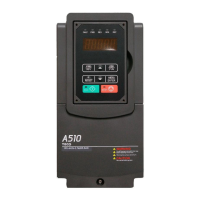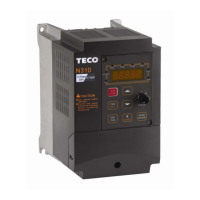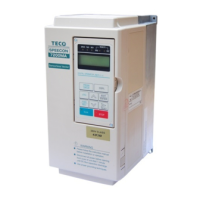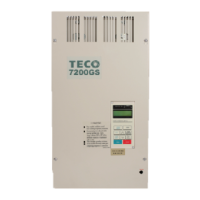4-75
10- 02 PID keypad input
Range 【0.0~100.0】%
10- 03 PID operation selection
Range
【0】: PID Function disabled
【1】: FWD Characteristic. (Deviation is D-controlled)
【2】: FWD Characteristic. (Feedback is D-controlled)
【3】: REV Characteristic. (Deviation is D-controlled)
【4】: REV Characteristic. (Feedback is D-controlled)
【5】: FWD Characteristic. (Frequency Command +Deviation D Control)
【6】: FWD Characteristic. (Frequency Command + Feedback D Control)
【7】: Reverse Characteristic. (Frequency Command + Deviation D Control)
【8】: Reverse Characteristic. (Frequency Command + Feedback D Control)
10- 03 =【1】.
Ddeviation (target - detected value) is derivative controlled in unit time set in parameter 10-07.
10- 03 =【2】
Feedback (detected value) is derivative controlled in unit time set in parameter 10- 07.
10- 03 =【3】
Ddeviation (target value - detected value) is derivative controlled in unit time set in parameter
10- 07. If the deviation is positive, the output frequency decreases, vice versa.
10- 03 =【4】
Feed back (detected value) is derivative controlled in unit time set in parameter 10- 07.
If the deviation is positive, the output frequency decreases, vice versa.
Note:
For 10-03 = 1 or 2, If the deviation is positive, the output frequency increases and, vice
versa.
For 10-03 = 3 or 4, If the deviation is positive, the output frequency decreases, vice versa.
When 10-03= 【5~8】, Output frequency = PID output frequency + frequency command (10-
03 = 【1~4】) .
10- 04 Feedback Gain coefficient
Range
【0.00 ~ 10.00】
10-04 is the calibration gain. Deviation = set point – (feedback signal×10-04)
10- 05 Proportional Gain
Range
【0.0 ~ 10.0】
10- 05: Proportion gain for P control.
10- 06 Integral Time
Range
【0.0 ~ 100.0】s
10- 06: Integration time for I control
10- 07 Derivative Time
Range
【0.00 ~ 10.00】s
10- 07: Differential time for D control

